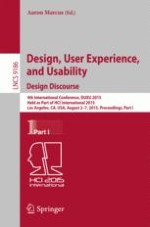The three-volume set LNCS 9186, 9187, and 9188 constitutes the proceedings of the 4th International Conference on Design, User Experience, and Usability, DUXU 2015, held as part of the 17th International Conference on Human-Computer Interaction, HCII 2015, in Los Angeles, CA, USA, in August 2015, jointly with 13 other thematically similar conferences. The total of 1462 papers and 246 posters presented at the HCII 2015 conferences were carefully reviewed and selected from 4843 submissions. These papers address the latest research and development efforts and highlight the human aspects of design and use of computing systems. The papers accepted for presentation thoroughly cover the entire field of Human-Computer Interaction, addressing major advances in knowledge and effective use of computers in a variety of application areas. The total of 132 contributions included in the DUXU proceedings were carefully reviewed and selected for inclusion in this three-volume set. The 61 papers included in this volume are organized in topical sections on design thinking, user experience design and usability methods and tools, DUXU management and practice, emotional and persuasion design, and storytelling, narrative and fiction in DUXU.
